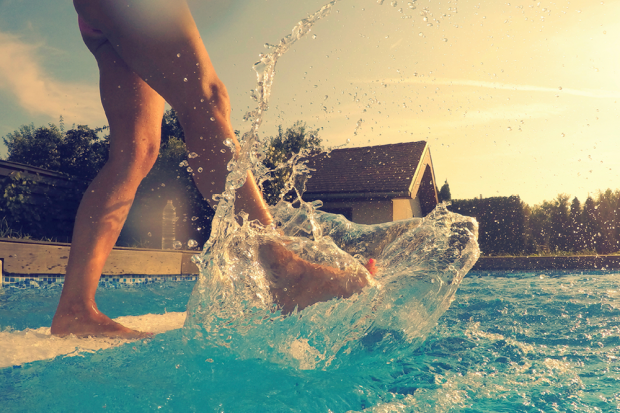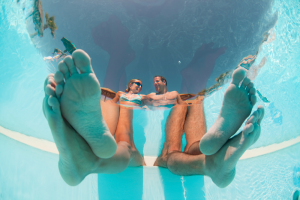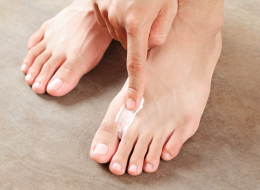Sink or Swim Foot Care Tips For Swimming Pool Trips
Swimming pools are a summer staple, but they’re also a foot health hazard. Find out how to avoid slippery falls, athletes foot, wrinkly toes, cramps and more.
We don’t mean to make your head swim, but pools just happen to be one of the worst places feet can tread. From fungal infections to foot cramps, swimming pools play host to a bevy of issues. However, most water-time foot problems can be avoided with a little foresight. And lucky for you, footfiles has all the foot health facts you’ll need to be swimming in a sea of safety.
How To Avoid Foot and Toe Cramps
Foot cramping is one of the most common complaints of active swimmers, and the pesky muscle contractions can happen suddenly and without warning. Podiatrists say most cramps experienced while swimming happen when a muscle is fatigued and overused, or if the swimmer is dehydrated or has an electrolyte deficiency. With that in mind, you should drink plenty of water and eat healthy, nutritious food before and during your time at the pool. You should also stretch before swimming and be aware of your current physical activity level, trying not to push yourself too hard too soon.
How To Avoid Bacteria and Fungal Infections
Swimming pool areas are a fungus and bacteria haven. Constantly wet and warm surfaces allow the tiny microbes to flourish, both around the pool and in the locker room and shower areas. Therefore, it’s wise to always wear a pair of plastic flip flops in public pool areas rather than go barefoot to help protect your feet against athlete’s foot, toenail fungus, plantar warts and other communicable diseases.
How To Avoid Wrinkly Toes
Skin pruning is a natural response to your limbs being submerged in water for long periods of time. Previously thought of as being waterlogged, scientists have actually discovered that the pruning is not due to water passing through the skin but rather is an evolutionary response that helped early humans grip onto wet stones and other surfaces while gathering food in rivers and streams. Having wrinkly fingers and toes is not a dangerous condition, but if it annoys you, try applying a barrier lotion like Vaseline or Eucerin to your hands and feet before jumping in the pool. Other things that help include limiting the amount of time you’re in the water, staying hydrated and avoiding extreme temperatures (like steamy hot tubs and cold, late night dips).
RELATED ARTICLES:
How To Avoid Slips and Falls
Slips and falls happen frequently around swimming pools and can lead to minor injuries like scrapes, bruises and broken bones, or major injuries like concussions and even death. You can prevent slipping on wet surfaces by walking slowly and cautiously (no running!) while barefoot, and by using handrails whenever possible. Meanwhile, be aware of tripping hazards like pool toys and floaty tubes.
Consider Wearing Waterproof Pool Socks
If you plan to spend a lot of time poolside, you may want to consider purchasing latex socks like Speedo Latex Socks, Saqua Waterproof Socks and Aqua Guard Swimming Socks. Not only do they keep feet clean and dry, the podiatrist recommended water socks simultaneously provide traction to prevent slips and falls, as well as protection against bacterial and fungal infections.
Notice concerning medical entries:
Articles having medical content shall serve exclusively for the purpose of general information. Such articles are not suitable for any (self-) diagnosis and treatment of individual illnesses and medical indications. In particular, they cannot substitute for the examination, advice, or treatment by a licensed physician or pharmacist. No replies to any individual questions shall be effected through the articles.







